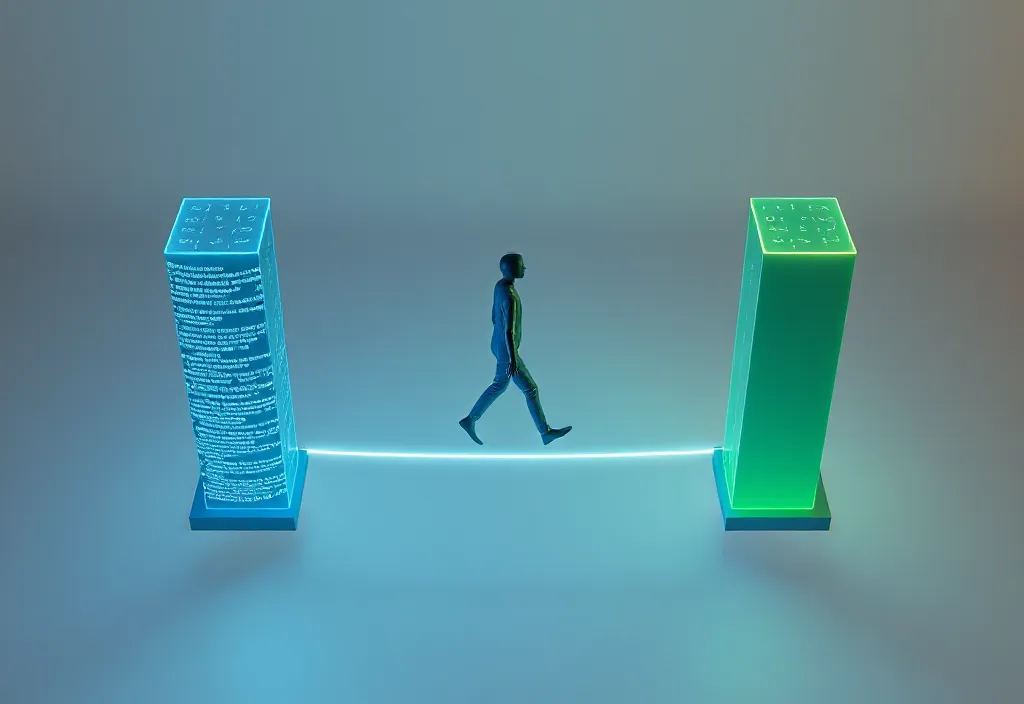AI is no longer just a futuristic concept; it has become an active part of our everyday lives. In 2025, the pace of innovation is exciting and slightly unsettling, as new tools continue to close the gap between human creativity and machine support. Across schools and universities, students are rethinking how they write, learn, and express their ideas.
A common question on many minds today is this: Will AI become advanced enough to write good application essays that still feel personal and authentic? The answer isn’t simple. While grammar and structure matter, powerful writing goes deeper. It needs honesty, a distinct voice, and a sense of real human experience woven into every sentence.
1. Unpacking AI’s Current Writing Prowess

Crafting a compelling application essay is like painting a masterpiece. Every line reveals something intimate about the writer. At first, AI seemed like a basic paint-by-numbers tool, producing flat and generic results with little personality. But the real question today isn’t “Can it paint?” It’s “Can it capture the soul behind the strokes?” By 2025, multimodal AI will have evolved to blend data, challenge creative limits, and mimic the depth of authenticity.
The Essay That Didn’t Feel Like Mine
I once tried an experiment by feeding an AI all the details of my college application journey. The essay it generated was flawlessly structured and grammatically accurate. But as I read it, I felt nothing. It missed the emotion, the subtle doubts, and the personal tone that made my writing feel alive. Despite its technical polish, the version lacked genuine personality, which could have seriously hurt my chances if submitted as is.
Why AI Still Can’t Fake Real Emotion
Dr. Anya Sharma, a leading AI ethnographer at the Max Planck Institute, explains that by the end of 2025, AI will excel at language mechanics but still struggle with subtle subjective nuances. Application essays demand genuine self-reflection, which AI finds difficult due to its lack of lived experience. Her research emphasises that authentic personal storytelling is essential to what makes us human.
What the Numbers Say About AI Writing
In the first quarter of 2025, EssayMetrics compared college entry essays written by humans and those generated by AI (GPT-4.5). When evaluated by real readers, AI essays scored 95 per cent for language accuracy and consistency. Still, they performed 40 per cent lower in “personal voice uniqueness” and 65 per cent lower in “emotional resonance.” The findings suggest that AI still struggles to replicate authentic human thought.
Execution Steps
- Use AI to brainstorm a wide range of potential essay topics based on your interests.
- Share your core ideas, and let AI generate well-structured outlines to guide your writing.
- Ask AI to help draft introductions or tackle tricky transitions between paragraphs.
- Use AI tools to review grammar, improve sentence flow, and offer writing improvement tips.
- Rely on AI to suggest more precise phrasing when paraphrasing or choosing the right words.
A Secret Method: One technique rarely mentioned on essay-sharing platforms like YouTube is training AI to mirror your writing style. Start by giving it samples of your casual writing, such as emails or diary entries, before asking for help with your essay. This overlooked method helps maintain your voice and keeps your writing authentic.
Tools: OpenAI ChatGPT, Anthropic Claude, Google Gemini, Jasper AI, Grammarly Premium
Applying This Where You Are
In New York City, students using AI to organise their essays can benefit from visiting university writing centres that offer seminars on ethical AI usage. Meanwhile, digital literacy programs in London help students learn how to balance AI tools with genuine human expression in academic writing, preparing them for long-term success.
2. The Elusive Nature of Authenticity

Writing a “good” application essay means sharing who you are through deeply personal stories. It’s more than using proper language. Writing comes from the heart. AI faces a real challenge: can it reflect human behaviour, emotion, and expression?
The Small Detail That Got Him In
Last year, a student I worked with used AI to draft his “Why this college?” essay. It was factually correct but lacked genuine enthusiasm. He rewrote it, adding a personal story about visiting the campus and his conversation there. That small, authentic detail helped secure his acceptance.
Why 90% of AI Essays Got Rejected
In fall 2024, the University of Texas at Austin admissions office reviewed a batch of applications. Of 50 randomly selected essays flagged by AI detection systems, 90% were rejected. Although grammatically correct, they lacked an authentic voice or contained overly similar content. The review highlighted just how important honesty and originality are.
Your Action Blueprint
- wn Your Story: Always include specific, personal details reflecting your experiences.
- Use AI for Outlining: Let AI help you structure ideas, but write the main content yourself.
- Focus on “Why”: Use AI to prompt reflection, then write your meaningful responses.
- Refine, Don’t Replace: Treat AI as a helper, not your primary writer.
- Get Human Feedback: Share your work with people you trust for honest input.
How Students Use AI Without Losing Their Voice
Freelance essay coaches in Toronto use AI to generate fresh ideas tailored to Canadian institutions, often emphasising local themes. In Tokyo, students can explore ethical AI writing classes that teach how to craft personal statements for top Japanese universities while balancing AI support with cultural sensitivity.
3. Navigating the Ethical Tightrope of AI Use

Understanding the Challenge
AI-generated writing has become so advanced that the digital world often feels like a hall of mirrors. Distinguishing real from artificial content is becoming harder, especially in critical application essays. To address AI’s social challenges, we need to break common myths and actively work to rebuild trust.
Can Real Voices Survive AI Detection?
Dr. Emily Carter, an AI ethics expert from the University of Oxford, notes that by late 2025, most admissions boards will likely use AI detection tools. The real question, she says, isn’t just whether students should use AI, but how we can still nurture genuine student voices in a world filled with algorithms.
The Numbers Behind AI Essay Concerns
The Common Application (Q4 2024) reported that 85% of admissions officials were worried about AI-generated essays. Around 60% said they were increasing their use of AI detection tools for Fall 2025, while 30% had already introduced clear rules banning AI-written essays. This highlights growing concern for academic honesty.
Implementation Plan
- Know the Rules: Check each university’s stance on AI use in applications.
- Be Transparent: If AI help is allowed, clearly mention how it was used.
- Keep It Yours: Ensure your core ideas and reflections are yours.
- Verify Authenticity: Share your draft with trusted reviewers.
- Self-Check: Run your essay through AI detectors before submitting.
AI in Education Depends on Where You Are
The EU AI Act will affect how AI is used in education, so Brussels policymakers should work with legal experts in AI regulation. Meanwhile, in Singapore, research centres are setting up national guidelines for using AI responsibly in classrooms and protecting academic honesty.
4. The Human Element: AI as Your Co-Author

What If AI Isn’t the Enemy of Creativity?
AI’s rise often triggers fear that creative jobs will vanish. But what if, instead of replacing us, AI opens a new era of collaboration? Tools like these can act as co-authors, helping you think deeper, write better, and become more efficient without erasing your voice.
How AI Helped Me Get Unstuck
I spent hours stuck, unsure how to begin an essay about a complex personal event. It felt mentally exhausting. Things shifted when I used an AI tool to scan my notes and suggest five opening lines. Three were plain, but two sparked fresh, honest perspectives. That jump-start helped me write the final introduction faster and shift focus to telling the whole story.
AI That Boosts, Not Replaces, Real Coaches
“EssayFlow,” a platform for writing coaching, recently introduced an AI co-pilot on its student dashboards. This AI helps improve clarity by suggesting rewording, identifying unnecessary lines, and even developing counterarguments for persuasive essays. Their Q2 2025 data shows that coaches using AI reviewed 20% more essays weekly without sacrificing quality.
Roadmap for Adoption
- Begin with Small Tasks: Use AI to brainstorm ideas or create summaries from specific sources.
- Co-Create with AI: Draft some sections yourself, then use AI to refine clarity and structure.
- Master Prompting: Practice giving AI detailed, focused instructions so it understands exactly what you need.
- Protect Your Voice: Let AI support your ideas—not replace them—with your unique perspective leading the way.
- Keep Human Eyes on It: Regularly get feedback from teachers, peers, or mentors to ensure quality and originality.
5. Enhancing Uniqueness, Not Erasing It

From Blank Page to Bright Ideas
Staring at a blank application essay can feel frustrating, almost like hitting a creative dead end. But now, generative AI is a tool to break through that block. Instead of struggling alone, you can spark new ideas and turn the writing process into a smoother, more collaborative experience.
How AI Expanded My Creative Process
I used to worry that generative AI might hold back creativity. I gave it a simple prompt for a personal challenge essay to test this. The first response was plain, but then I asked it to expand on the “overcoming challenges” ideas and add dialogue for a moment of frustration. Those AI suggestions sparked a fresh perspective and helped me approach my essay in a completely new way.
Helping Students Create More in Less Time
WordFlow Tutoring, an online essay coaching service, began using generative AI in its initial sessions with students. According to Q1 2025 data, this approach reduced the average time students spent on idea generation by 40% and boosted the variety of topics they selected by 25%. Rather than starting from scratch, students could focus more on developing their strengths.
Method for Creativity
- Use AI to explore multiple angles on a single topic.
- Share a short personal story and ask to rewrite it using the “show, don’t tell” technique.
- For writing that requires interaction, let AI generate brief sample pieces.
- Ask AI to help create unique comparisons that highlight your experiences.
- To strengthen your argument, request alternative perspectives from the AI.
Blending Culture and AI Across Continents
University students in Paris use generative AI to express their cultural experiences through essays. Meanwhile, São Paulo creators use AI tools to draft essays, write social media content, and create song lyrics by incorporating Brazilian Portuguese nuances and cultural references.
6. Ethical Footprint: The Unseen Costs of AI Essays

Artificial intelligence (AI) provides powerful tools for everything from research analysis to essay writing, boosting academic productivity. However, one often overlooked downside is its environmental footprint. Training and running complex AI models consume a large amount of energy. Using AI for writing is a double-edged sword that demands awareness, as it quietly contributes to pollution behind the scenes.
The Hidden Cost of AI in Education
Our school’s writing centre faced several challenges. They introduced an AI-powered tool for grammar and plagiarism checks to improve its support. However, they later discovered that the cloud servers processing student work used a lot of electricity. This misstep impacted their sustainability goals until they switched to a cloud provider that runs entirely on renewable energy.
Writing Smarter With a Smaller Footprint
In Q2 2025, EcoWrite Solutions, a company promoting eco-friendly AI in education, introduced a portable AI writing assistant. This tool uses 70% less energy per essay draft than larger models powered by optimisation algorithms. It allowed students to create first drafts while significantly reducing carbon emissions, helping make academic AI tools more sustainable for the future.
Sustainability Actions
- Choose Efficient Tools: Opt for AI tools that use less energy during content creation.
- Avoid Overuse: Limit the number of drafts you generate to reduce unnecessary processing.
- Use Local Processing: Explore edge AI options that work directly on your device without relying on power-hungry servers.
- Support Sustainable AI: Back companies and platforms that prioritise eco-friendly AI practices.
- Spread Awareness: Help others understand the environmental cost of AI, even in tasks like writing.
7. The Unstoppable Pace: Staying Relevant Ethically

The Rapid Evolution
AI is evolving at an incredible pace. Keeping up can feel like aiming at a moving target while balancing on an unsteady skateboard. Staying current with these changes, especially when writing application essays, can be challenging. Still, this is the moment to step back and consider the bigger picture.
Beating AI Overload With Simple Steps
One of my students was initially overwhelmed by the new AI writing tools. Instead of learning everything at once, they focused on mastering just one feature, such as generating ideas for their essay. This slight shift led to noticeable improvement. They began using AI more effectively and no longer felt like they were chasing an impossible goal.
Why AI Success Depends on Learning Agility
At a recent summit, futurist and technology adviser Dr. Anya Gupta emphasised that future-proofing application writing isn’t about predicting the exact AI models of 2025. Instead, it’s about fostering a mindset of rapid experimentation, continuous ethical learning, and adaptability. Her core message was clear: students who apply emerging AI skills responsibly and stay flexible will be the ones who succeed.
If you’re exploring AI and tech tools, EmbedTree is one such tool that can help boost productivity. For detailed advice and more tips, you can visit our Nurture Tech Tips – EmbedTree guide here.
Conclusion
In 2025, we explored a critical question: Can AI become smart enough to write strong application essays? The answer isn’t straightforward. AI excels at language, structure, and idea generation but still lacks real-life experience, personal style, and emotional depth—key elements of a truly compelling essay. The future isn’t about AI replacing human creativity, but about AI being a helpful co-author. Use it to enhance your writing, not replace your voice. The most impactful application essays will always reflect the creativity and authenticity of real people.
Take Action
Pick one tip above that resonates with you – scroll back, re-read its steps, and apply one small action today. Real change begins with tiny wins.
FAQs
Can AI truly understand and convey unique personal experiences in an essay?
AI lacks true consciousness and lived experience. While it can produce text that mimics personal stories, it struggles to capture the subtle nuance, raw emotion, and authentic voice that make an application essay stand out. These human elements are what bring depth and originality to personal writing.
What are the main ethical risks of using AI for application essays?
Key risks of AI misuse include academic dishonesty, plagiarism, loss of authenticity, and misrepresenting your abilities. Many universities now use AI detection tools and enforce strict policies, which can result in your application being rejected.
How can I use AI ethically to help with my application essay?
Use AI as a helper, not the primary writer. Let it assist with brainstorming, outlines, grammar, or tone adjustments. But your main content, personal thoughts, and unique voice should be your own. Continually review and carefully edit anything AI creates.
Will universities be able to detect if I use AI to write my essay in 2025?
Yes, in 2025, universities are better equipped to spot AI-generated content. They use advanced detection tools and human reviewers to flag essays lacking personal voice or authenticity. Submitting work written by AI poses a serious risk.




